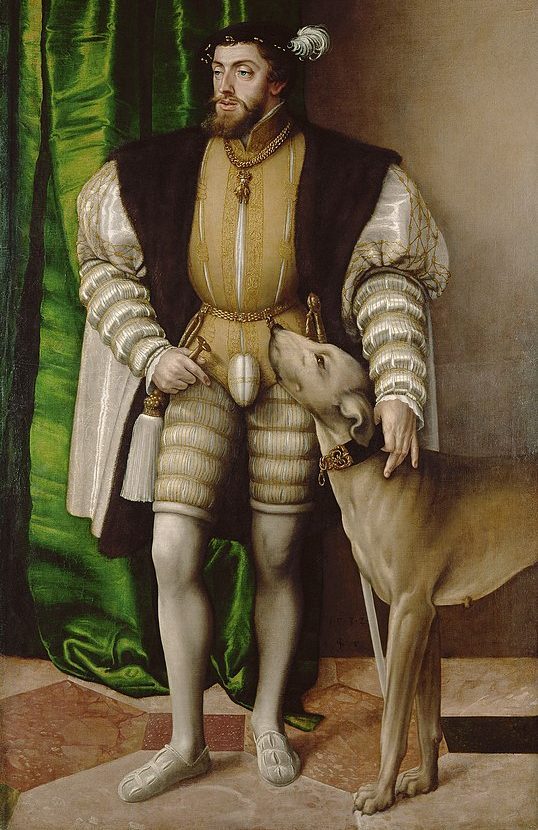
The dossier exhibition L’imperatore e il duca. Carlo V a Mantova (The Emperor and the Duke. Charles V in Mantua), at Palazzo Te from March 24th to June 25th, 2023, offers the public a reflection on the cultural meaning of contemporary Europe, starting with the figure of Charles V and his alliance with the Italian courts and recounting the emperor’s arrival in Mantua in 1530, celebrated with the sumptuous feast that Federico II Gonzaga organized in the halls of Palazzo Te, under the direction of Giulio Romano.
Charles V’s visit in Mantua – immediately following his coronation and renewed alliance with the Pope after the sack of Rome in 1527 – appears fundamental to mark the sense of Europe of those years, being Charles V the apex of an empire no longer Flemish or Spanish but European and global. At the same time, the triumphal apparatuses designed by Giulio Romano for the imperial procession in Mantua and the celebration at Palazzo Te on April 2nd, 1530, must be read as symbolic elements of the Gonzaga’s cultural strategies to legitimize their position in the geopolitical chessboard of the first half of the 16th century.
Curated by Daniela Sogliani and Marsel Grosso, the exhibition at Palazzo Te revolves around the Portrait of Charles V with a Dog executed by Jakob Seisenegger in 1532 and lent by the Kunsthistorisches Museum in Vienna. In a dialogue that ideally brings to life the meeting between the emperor and the duke, the artwork is displayed alongside the Portrait of Federico II Gonzaga by Titian, in a reproduction made by Factum Foundation from a high-resolution scan of the work – housed at the Prado Museum in Madrid – and from a Giovanni Britto’s print of the lost Portrait of Charles V in Armor executed shortly before by Titian.
Set up in the Emperor’s Room at Palazzo Te, the work by Seisenegger – a court painter of Ferdinand I of Habsburg, the emperor’s brother – is the last in a series of five portraits of Charles V that the artist made between 1530 and 1532. The painting was reinterpreted by Titian in 1533 in a celebrated version now in the Prado. Portrayed full-length and life-size, the emperor wears a sumptuous dress appropriate for court ceremonies. Rather than the military character of the leader of an army, the Austrian painter dwells on the symbolic and political significance of the sovereign’s dress, over which the collar of the Order of the Golden Fleece (Ordre de la Toison d’or) stands out. The dog is perhaps the beloved Sampere, whom Charles V had brought on a wagon in November 1532, when he crossed the Adige River in the direction of Mantua.
Alongside the two portraits, a corpus of other works is presented: these works are significant for understanding the scope of the first imperial journey to Mantua that would result in the appointment of Gonzaga as the first duke of the household; the works presented are a collection of twelve documents from the Mantua State Archives recounting the court’s preparations for Charles V’s arrival in 1530 and subsequent stay in 1532, Giovanni Britto’s xylography of the Portrait of the Emperor in Armor from the Istituto Centrale per la Grafica in Rome, the Chronicle of the Imperial Sojourn in Italy of 1529-1530 from the University Library of Pavia, and a drawing from a private collection with a triumphal arch referring to the circle of Giulio Romano that may represent one of Pippi’s interventions for the apparatuses set up in the city.
The figure of Charles V stands over the advent of transformations that were decisive for the future. In a time span which opens with the reign of Charles V and ends with that of Philip II, the political scene on the continent appears to have changed profoundly. It is a new time of nation-states, in which the imperial principle is set to decline while the possibility of a concrete institutional articulation separating political and religious power looms.
“The set design prepared for the reception of Charles V at Palazzo Te is full of implicit anticipations of all this,” explains Director Stefano Baia Curioni, “the emperor is the idea of Europe that Gonzaga, even with his diplomatic ambiguities, chooses for the future of his state; and the emperor’s reception fully reflects the mixture of personal proximity, wonder, luxury, casual dismissiveness and hesitant reverence that composes the sense of the apparatus of the court. A place where power, calculation, wonder, domesticity, intimacy, luxury, distance, faith and cynicism, strength and desire coexist in a balance guaranteed by majesty. To this emperor, Federico offers a palace full of myths, humanism, a palace devoid of religious references, devoid of an echo that could alter, with precepts or moral references, a pleasure of living that faces modernity. At Palazzo Te, morality lies in people, in their nobility, in implicit rules of behavior, all interior and internal to a very select group. The celebration for Charles V, like the whole design of Palazzo Te, is a song that rises, sung, before the wind of things, of progress, rises to break, sweep and create the new that looms. That is why it was chosen to introduce his memory in this year that is dedicated to recognizing some features of the relationship between cultural Europe of Renaissance and the cultural Europe of contemporary times.”
Promoted by the Municipality of Mantua, produced and organized by Palazzo Te in collaboration with Factum Foundation, with the support of Friends of Palazzo Te and Mantuan Museums and with the contribution of Fondazione Banca Agricola Mantovana, the exhibition is the first event in the 2023 exhibition season of Fondazione Palazzo Te “Mantua and the Europe of Cities” dedicated to the theme of Europe as a cultural and artistic homeland capable of safeguarding the value of freedom.
